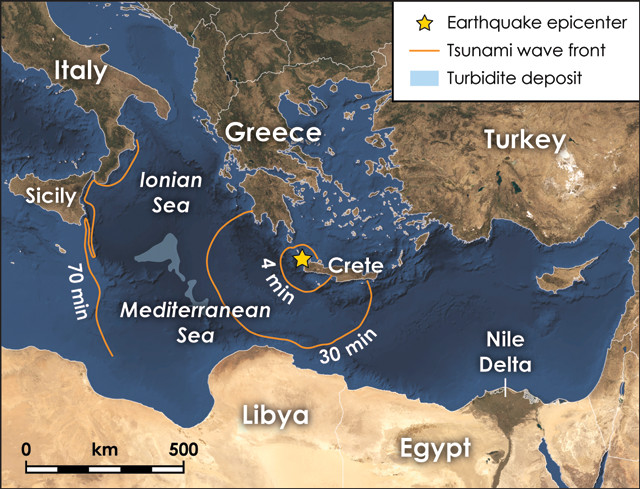
by Mary Caperton Morton Tuesday, July 12, 2016

The Crete earthquake and tsunami in A.D. 365 devastated much of the Mediterranean. Credit: K. Cantner, AGI.
In A.D. 365, a giant earthquake with an estimated magnitude of 8 or higher struck the eastern Mediterranean, devastating Crete and causing widespread destruction throughout Greece, Egypt, Libya and Spain. The event was quickly followed by a tsunami that inundated the southern and eastern Mediterranean coasts, stranding ships as far as 3 kilometers inland. Now, scientists have uncovered evidence of a massive turbidity current triggered by these events in the Mediterranean.
Turbidity currents are underwater landslides that leave an apron of debris. In a new study in Geology, researchers dated the Augias turbidite, a “megabed” of mud that is visible in seismic studies of the Mediterranean seafloor. Radiometric dating of this layer, which is spread over 150,000 square kilometers from the northern Ionian Sea to the Mediterranean Ridge south of Crete, revealed that the megabed was indeed deposited during a single event between 364 and 415.
“Unlike interpretations that relate this turbidite to different triggering events, including the Santorini Caldera collapse [sometime between 1650 and 1450 B.C.], the turbidite can be traced back to a large tsunami sourced from the A.D. 365 Crete megathrust earthquake,” wrote the team, which was led by Alina Polonia of the Institute of Marine Sciences in Italy.
© 2008-2021. All rights reserved. Any copying, redistribution or retransmission of any of the contents of this service without the expressed written permission of the American Geosciences Institute is expressly prohibited. Click here for all copyright requests.